There and Back Again
NOTES FROM THE UNMUTE 2021 STAGE FT. MARC AMIGONE
What does it mean for marketing to be in the shoes of sales? On the contrary, what does it mean for sales to be in the shoes of marketing? Having performed both the functions with ease and aplomb, Marc Amigone, Sales Director at Impact, is here to share the secret sauce on how both these functions can go hand in hand without holding off the horns.
Marc is a results-oriented marketing professional with a passion for living life to the fullest. His experience ranges from consulting to executing lead generation, marketing automation, product marketing and product adoption campaigns. Marc's personal interests include yoga, mindfulness, positive psychology and the intersection of all the above
Here he is, narrating his journey through the mountainous regions of Sales and Marketing and sharing tips on how to bring Sales and Marketing together.
All right. Well, I'm super, super excited to be here. Let me give you some background information about me first. I'm Director of Sales at Impact, a digital sales and marketing agency based in New Haven, Connecticut.
And as the title of my session says I've lived on both sides of the sales and marketing divide here. So I'm at Impact. Now I'm the Director of Sales. We help businesses grow their business through digital sales and marketing, and we're a HubSpot partner agency since about 2010.

And I'm going to tell you today a little bit about my journey and kind of how I’ve gotten to where I am and share some insights for all of you guys, about what I've learned at Impact and my experience in sales and marketing.
I graduated from university in 2007 and moved to New York City and tried to make it as a journalist. I had a writing background so I thought that's what I wanted to do, and then quickly realised public relations and marketing was a much better and growing field than journalism was. So I started working in marketing back then, little by little kind of worked my way up and then had a few different jobs here.
And then, I moved to Thailand for about six months, moved back and then got my job at HubSpot where I was an inbound marketing consultant there for a couple of years.
So that was my first foray into digital marketing in a real sense.
I learned a ton about SEO and software and all kinds of cool stuff like that. I left HubSpot and ended up at a company called ACIS, which is the American Council for International Studies.
And I was on their marketing team where I was responsible for all of their content marketing, and their social media, and was kind of like in the heart of Content Marketing World and kind of trying to solve the challenges of lead generation traffic to the website, that sort of thing.
And then a friend of mine took me out to lunch who I work with a HubSpot who was working at Impact at the time in the sales team, he was telling me about his experience working in sales, and I was seemed to be married and soon to become a dad.
And I have two kids now, and this is you know, about four or five years ago. And I was thinking to myself “Okay, working in sales, I can make more money, I could grow my career in that way”.
And so I took a job at Impact and now I'm the Director of Sales there, it's been coming up on four years working there. So all that to say, you know, to get from point A to point B has not been a straight line, it's been way more kind of this looping around and stuff and it's been a really interesting journey.
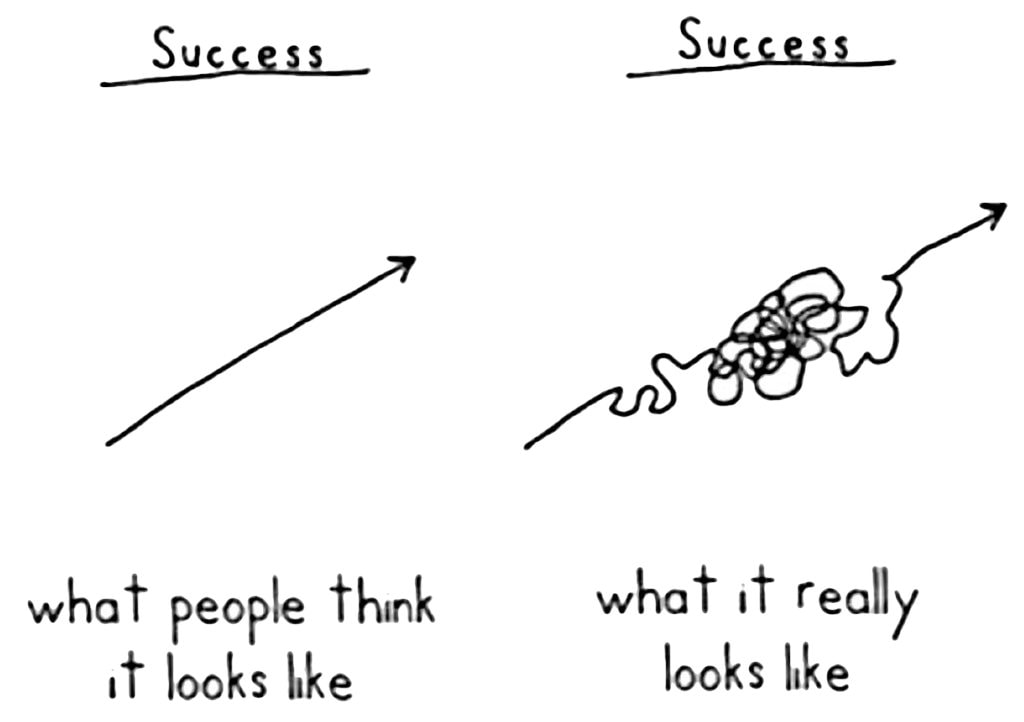
I've learned a ton along the way. So what I have pulled up here is some examples of some content that I created when I was at ACIS.
I don't mean to drag ACIS 's name through the mud or anything like that. But these are all blog posts or convertible offers that I authored when I was there. So basically everything you see here is what I would call fluffy marketing content.
When I say fluffy, I mean, it generates a lot of traffic and does absolutely nothing to help the sales team. This is the example of what we call out all the time at Impact as what you should not be doing with your content marketing efforts.

So if there's anybody that is thinking about creating content that's catchy, and fluffy and know, buzz-worthy, but has absolutely nothing to do with the service that you're selling, please don't do it. It's going to do absolutely nothing. It might generate some traffic to your website. But all that's going to do is make your bounce rate to your website high.
And it's just going to make your sales team roll their eyes at you a lot, which is exactly what happened to me.
When I went into our sales and marketing meetings and said “Hey, everybody is super exciting news. I just published these 17 free recipes, ACIS world cookbook” and they're like, “Great, what does that have to do with our target market”.
Our target market was teachers. And they would take their students on these trips abroad to Europe and South America and places like that. I thought “Okay, teachers like food, teachers like things that they can do in their classroom”.
So you know, “These five great music videos for your German class”, was probably one of our top-performing blog posts in terms of traffic, but because there's a lot of people searching for that and looking for that content does not by any stretch mean that those are people with the intent to then purchase our products.
There's a huge gap there that I was not taking into account whatsoever. I was just thinking like a marketer. And I was thinking, “Okay, traffic is good, we get as much traffic to our website as possible, we'll worry about converting that traffic into leads and sales later.”
So we had a lot of traffic and people downloading the cookbook and nobody becomes a customer at the end. So there's no real conversion or intent behind it. And that’s not great, and I would not recommend that as a course of action.
So I'm here to tell you to kind of learn from my mistakes essentially.
So I left ACIS and moved to Impact where I was introduced to the concept of “They ask, you answer”
They Ask, You Answer
It's a book written by a guy named Marcus Sheridan, who's a Partner at impact. And the concept is extremely straightforward. Your customers are asking a question and you answer it in the form of marketing content, whether that's a video, blog post, or an ebook.

It gets at the basic philosophy of “what is my customer thinking and therefore asking”.
If you're taking that approach to your marketing, you're obsessed with what your customers are thinking, you're obsessed with what they care about what they're worried about what they're afraid of, and your job is to be the best and most trustworthy source of information about those things.
If you do that good things will happen in your sales and marketing. That was kind of the experience that Marcus had when he was running a business and started swimming pools in 2008-2009.
So he realised that if I just answered my customers’ questions, good things will happen. And he started doing that and started seeing the traffic to his website go up, started seeing the sales increase.
And then he realised there are five areas where most people's problems and people's questions centred around and if you focus on those, then those are the people that are most serious about buying this product if they're asking questions about cost, problems, comparison reviews, and best in class.
These are are the “big five” as we like to call it.
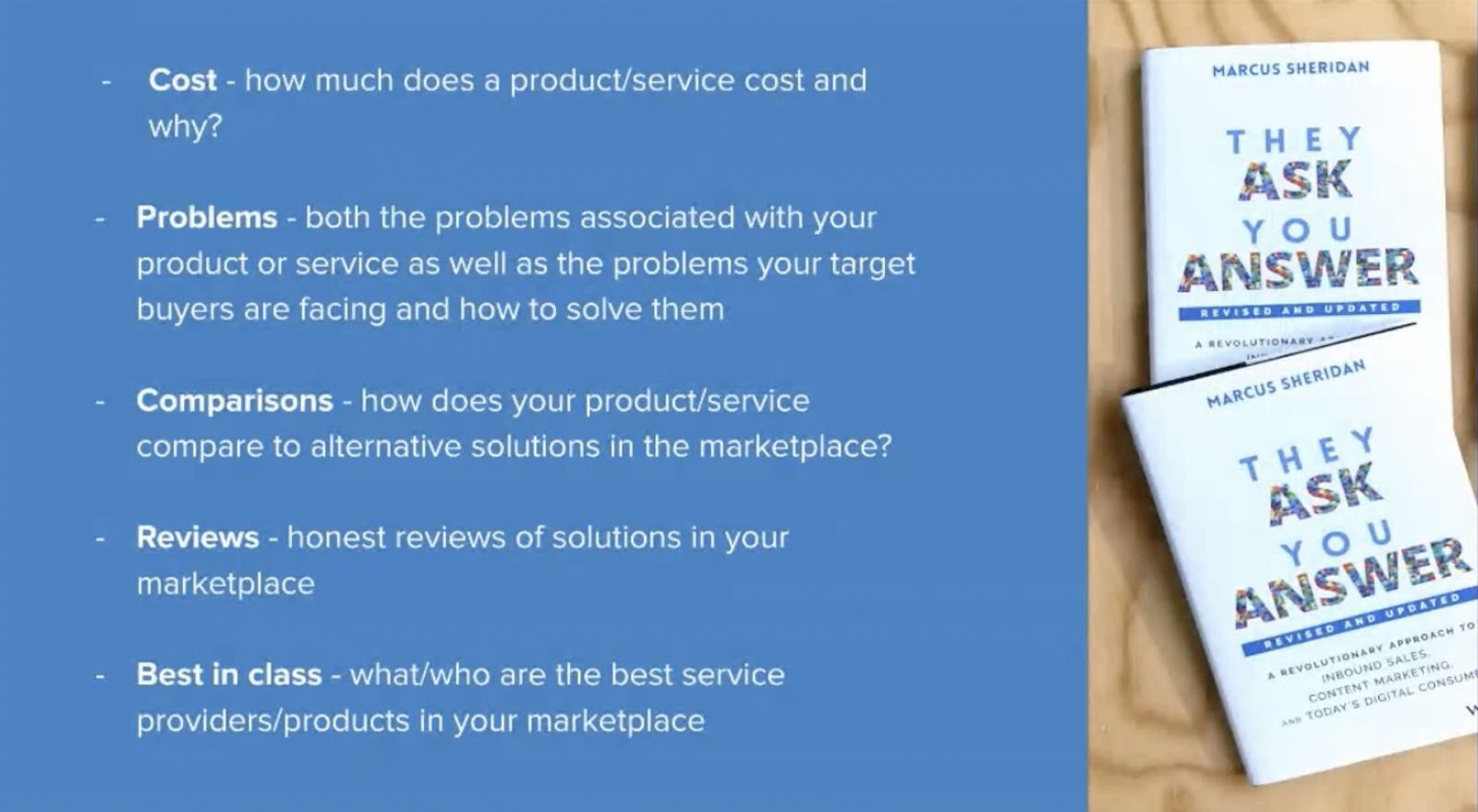
And that's the basic thing that we weren't doing at ACIS.
We were doing a lot of these fluffy blog posts, but we weren't talking about costs. We weren't talking very clearly and directly, to explain to people how much something costs, and we also weren't talking about the problems that they're facing. Specifically, problems you’d face when you're evaluating buying software, if you're evaluating buying professional services, evaluating buying a product, and the problems associated with it.
If you're honest and transparent about where those problems are, people will trust you more, and they'll buy from you. And then, comparisons. If you're comparing one thing to another, it's probably because you're ready to make a purchasing decision, and reviews and best in class are the same things in there.
Changes in the Buyer Journey
So the basic truth of “they ask you answer” is that buyers have changed.
We're not in this place where we used to be where salespeople had all the information where salespeople were able to just kind of say, “well, I know everything, and you have to talk to me to get more info”. Those days are over.
We're in a place now where people have more authority and have more capability of finding information on their own without necessarily having to talk to somebody like me, a salesperson, they can find that information without me and they prefer to learn as much as they can before having a sales conversation.
I mean, think about the last purchase you made and how much you tried to avoid talking to a salesperson before you, you know, got into a sales conversation. So people want to do that as much as possible.
And the more that they can learn about your product or service before they buy, the more that they'll trust you at the end of the day. The more that you can be transparent and honest, the more they'll trust you and trust is the foundation of every sale.
That's the basic truth about They Ask You Answer.
80% of the buying decision has already been made before a prospect talks to a salesperson. The truth is that people if they're going to talk to a salesperson, it's only because they have really exhausted all other options. And they're educated, they're ready to buy and go “okay, answer these few questions for me, and then we'll close the deal”.
That's the way people like to make purchasing decisions these days. And again, I've mentioned this before, but if our customers or prospects have a question problem or concern, we should address it honestly and transparently on our website, that is a statement that somebody doing the answer will make.
So I learned about all this working at Impact. And I wish I knew that before, when I was a content marketer, because my life would have been very different, the company's success would have been different, my interaction with the sales team would have been very different, it would have been totally different story.
So like I said, previously I was starting to go top of the funnel with the super fluffy, you know, blog posts about music, videos, and recipes. But really what I should have been doing the same, what are the questions people are asking at the bottom of the funnel? Are they ready to make a purchase? What are they wondering about and thinking about?
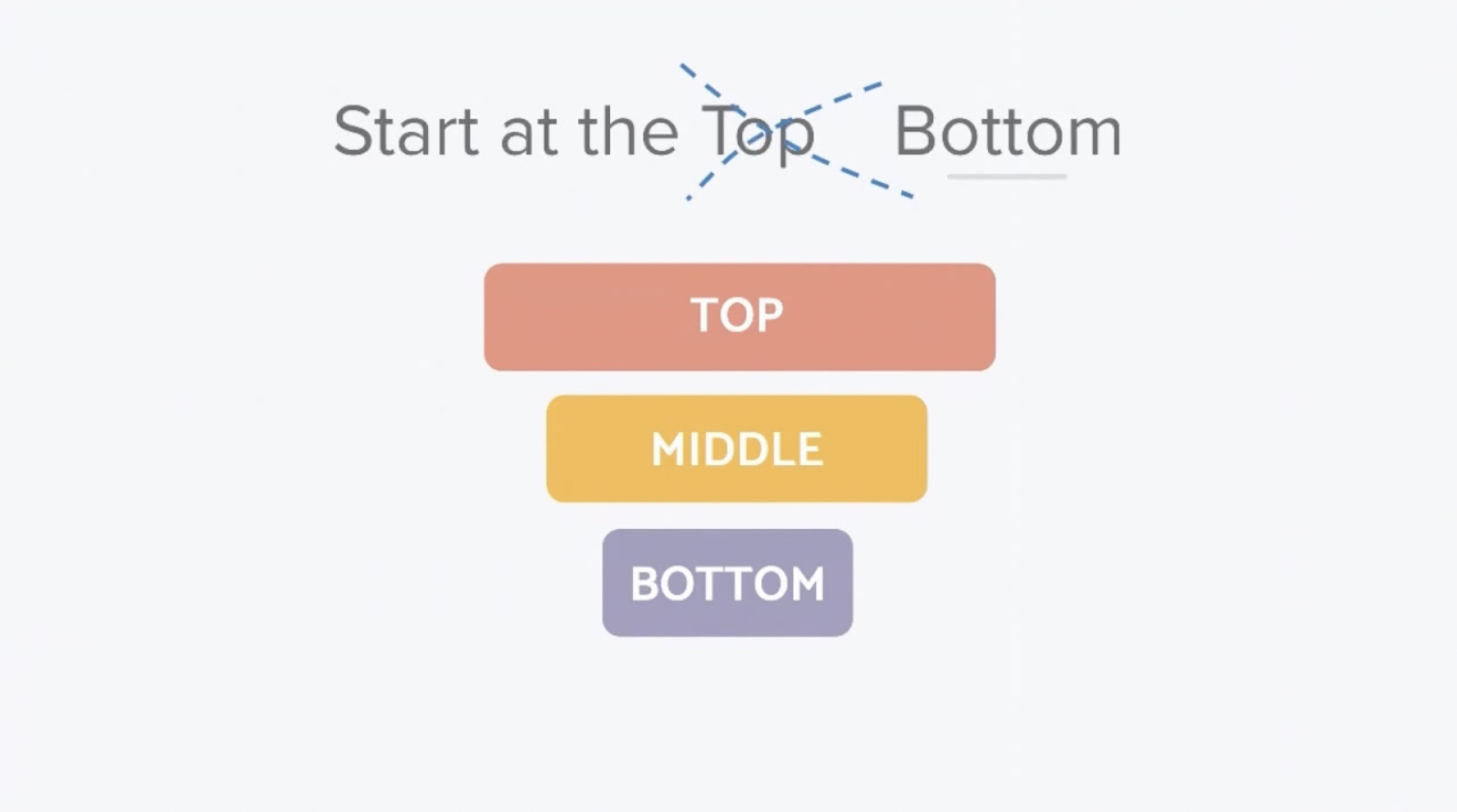
So anyway, long and short of it is that at the end of the day, you want to be honest, you want to be transparent about what you're going to be doing to help people and answer the questions. And that's the only way you're ever going to build trust.
By trying to kind of game the system, so to speak, is not going to do you any good.
Another thing that I want to show you guys is some screenshots from what we call our buyer's guide. So this basically shows you what you need to know before you're going to have a sales conversation. So we're trying to knock out all the basic questions, anything that you might be wondering about, that's going to come up like how much our services cost, what they entail, are you a good fit or a bad fit, we send this to them before the call.
And if they don't read this call, read this buyer's guide before the call, we don't do the call, we can we cancel the call and say, “Hey, you didn't do the homework”
We call that assignment selling and use a really cool tool to do that, called Paperflite.
But basically, for anybody out there that is working in marketing or sales, that’s something you should think about. What are the things that every single person is going to ask about in every single sales call they’re going to want to know the cost, they're gonna want to know all the things that are based on the basic questions.
Right. So how do you get to this point? How do you get to the point where you're having sales and marketing teams talking to each other?
There's a way to facilitate these conversations so we're all working on the same team. And we call it the revenue team.
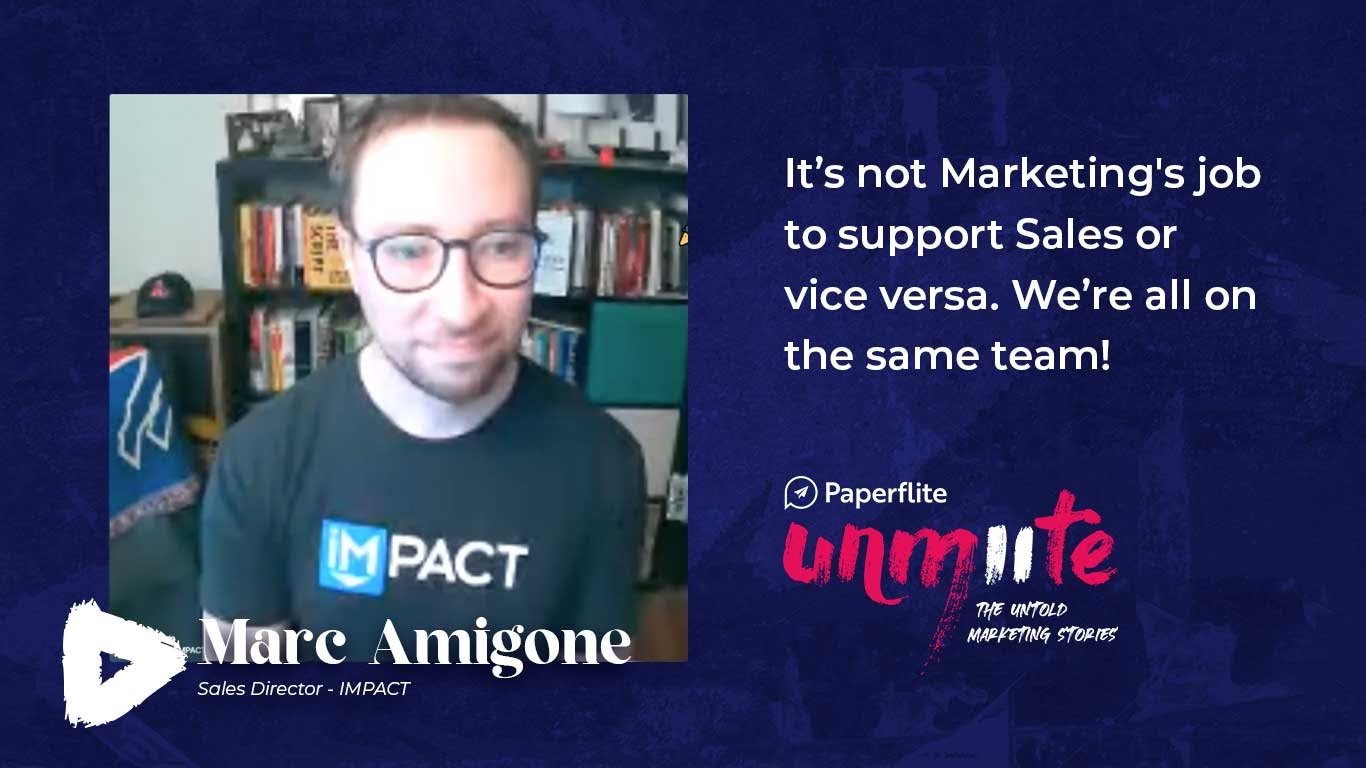
The Revenue Team: Bringing Sales and Marketing Together
That's something that we at Impact help our clients do is to form these revenue teams. So you're not getting these conversations where the marketing team is saying, “Well, we're working on this today, and it's going to be so great”. And the sales team is thinking “Yeah, whatever, like you guys are just wasting everybody's time, I could actually use a marketing team that's going to do this for me”.
And the marketing team is thinking to themselves “Man, the sales team complains all the time. All they do is just complain and say they don't have enough assets to help them succeed. Why don't they just, you know, do their job and stop complaining”
If you work together in the right way if you start to facilitate the conversation between those two teams, that’s something I've learned from being on both sides of the equation, that's when you can really make magic happen with sales and marketing.
And now you know, when the marketing team at Impact publishes some new content that is really useful in the sales process and answers one of our buyer’s questions our sales team jumps for joy. Because we know it's going to help us in our sales team. It's not just another fluffy piece that we're just like, whatever, you know, marketing is doing their marketing thing doesn't have anything to do with us.
That's not how we operate at Impact and our clients agree because we use, “They ask you Answer” as a framework. And we facilitate that conversation between our two teams.
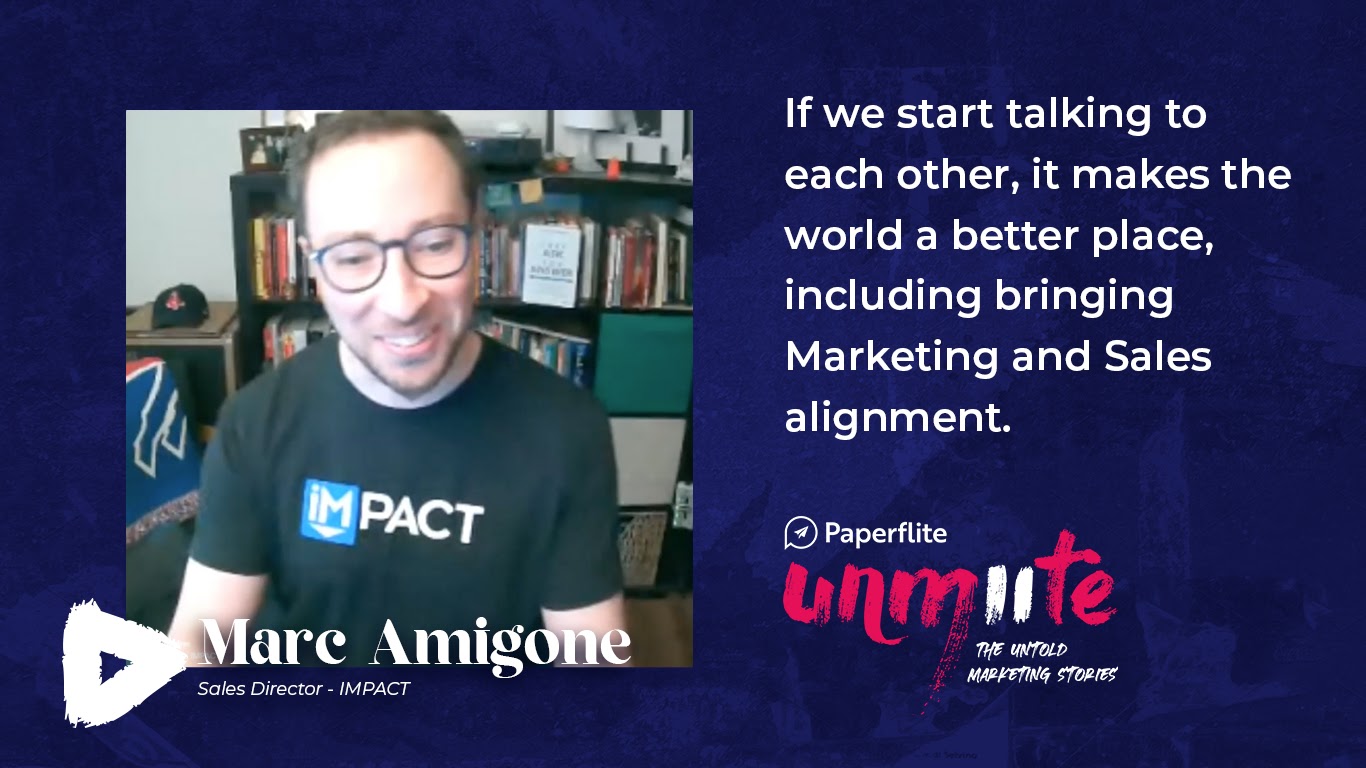
Again, I'm not here to sell everybody on impact. I'm really just my main goal here today is to think about what are your buyers thinking? What are your buyers’ questions? How can you answer them? And if you do that effectively, and get your sales team to bind to that process, the sales and marketing relationship is going to be dealt with that much stronger.
Other Notes from UNMUTE 2021
Forget Customers. Focus on Value
Piñatas break. Sales pipelines shouldn’t.
